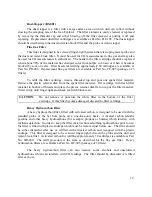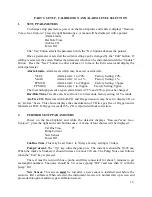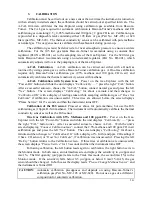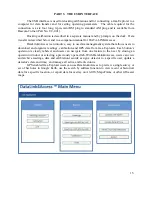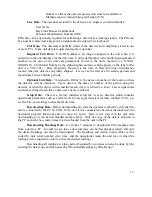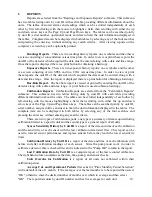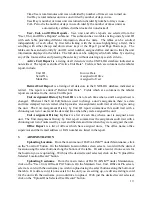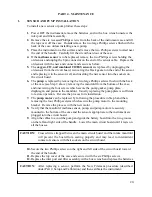
Operational Modes.
The instrument operates in four distinct modes, “Monitor”, “Track
Gas”, “Bar Hole” and “Purge”.
Monitor:
The detector shows the concentration of natural gas (methane) in air in steps
of 0.05% GAS (1% LEL) up to 5% GAS (100% LEL) and then in steps of 1% GAS up to 100%
GAS. The concentrations of CO, H
2
S (HS), and O
2
are also shown if the unit is equipped with
the corresponding sensors (see below).
The peak reading for GAS is retained and displayed along with the current readings until
another mode of operation (Track Gas or Bar Hole) is chosen, or a new zero is obtained, or the
unit is turned off.
Models EGI-201, EGC-301, EGO-321, EGA-411, and EGA-611 display concentrations
in increments of 1% LEL up to 100% LEL and then in increments of 1% vol. from 5% to 100%
GAS. All other models display % vol. gas in increments of 0.05% up to 5% and then in
increments of 1% to 100% GAS.
Track Gas:
Connect an appropriate probe (see Section 7) and select "TRACK GAS".
The display shows
"TRACK GAS"
for a few seconds. After warm-up, the display shows the
concentration of gas in air in parts per million by volume (ppm). Advance a probe along the pipe
or other conduit suspected of having a gas leak. The beeper will sound if the ambient
concentration of gas rises above 20ppm. Since methane is lighter than air, track a conduit from
above whenever possible. Sometimes it is desirable to silence the beeper during a leak survey.
To silence the beeper, press the middle switch. “
Mute
” will appear on the display and the beeper
will be silent. If the gas concentration goes over 10,000 ppm, (1% Gas) the unit automatically
enters the Monitor Mode.
As in the Monitor Mode, the peak reading for Gas is retrained and displayed until another
mode of operation is chosen, or a new zero is obtained, or the unit is turned off.
Bar Holing:
The detector may be used to measure gas levels in sampling holes used for
locating underground natural gas resulting from seepage or leaks in a conduit. Gas
concentrations in a bar hole near a significant leak will exceed several percent. Therefore an
alarm for gas is likely, but since it is not relevant to the ambient atmospheres above ground it
will not sound. During bar-holing, the alarms for all gases are automatically turned OFF.
To bar hole, select an appropriate probe (see Section 7) and set the front panel to Bar
Hole (BH). The instrument will automatically clear any residual gas and check for clean air. The
pump is then turned off and the instrument is ready for bar holing. After inserting the probe into
the bar hole, press “
GO
” (the middle switch). The pump is turned on and the instrument samples
gas for a fixed time
(factory set time is 15 seconds)
. Readings during sampling are shown on
the display. At the end of the fixed time, the instrument turns off the pump and displays the peak
and sustained readings. Both values are in % GAS.
If in the course of bar holing, water is encountered, press the left “Stop” button to stop
the pump. A water-stopper (Fig. 2 in Section 8) will prevent water from entering the instrument.
WARNING:
If a check is to be made for trace amounts of gas, for example around the
foundation of a structure, the Monitor or Track Gas – not the Bar Hole –
mode should be used.
Purge:
The purge mode measures the concentration of natural gas in nitrogen with a
resolution of 0.1% by volume from 0.0% to 100.0% as sensed by the thermal conductivity
sensor. Purging air-filled lines into service requires lowering the oxygen content to less than
9.7% (or natural gas concentration over 70%).
5.

















